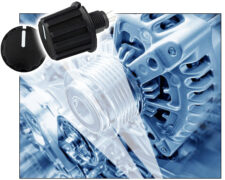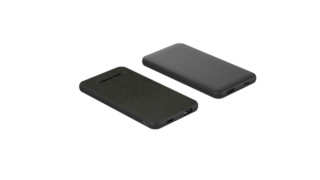The COVID-19 pandemic has encouraged engineers to consider ultraviolet (UV) light for disinfection and sterilization products that “deactivate” SARS-CoV-2 (the virus that causes COVID-19). Conventional disinfection and sterilization products use low-pressure mercury-vapor lamps to emit in the required UV-A spectrum for pathogen elimination. But LEDs offer many advantages, including greater efficiency, higher light output, longer life, and lower lifetime costs.
UV-A LEDs are relatively easy to manufacture—by adapting blue light LEDs to the near-visible spectral range—and have been available for over a decade for industrial curing applications. But SARS-CoV-2 deactivation requires more energetic UV-C.
In the last several years, commercial UV-C LEDs have become available. However, these devices can’t be considered as a simple drop-in replacement for conventional mercury-vapor lamps because they introduce many new design challenges. For example, disinfection and sanitization products demand high and tightly controlled radiant flux to ensure proper operation. Moreover, UV-C LEDs are not only dangerous to bacteria and viruses, but they are also hazardous to humans, so adequate protection is an important part of the design process.
This article will briefly discuss the types of UV radiation and its role in sanitization and pathogen control. It will then describe the benefits of using LEDs as the radiation source as well as the associated design challenges. The article will then introduce solutions to these challenges using example UV LEDs from Luminus Devices, Vishay Semiconductor Opto Division, and SETi/Seoul Viosys.
Why use UV light for pathogen control?
UV radiation fits into the electromagnetic spectrum between visible light and X-rays and comprises short wavelength (400 to 100 nanometer (nm)) photons with corresponding high energies. Radiation wavelength is inversely proportional to frequency: the shorter the wavelength, the higher the frequency (Figure 1).
 Figure 1: Along the electromagnetic spectrum, UV radiation falls just below visible light at a wavelength of between 100 and 400 nm and is subdivided into three types, A, B, and C. (Image source: Government of Canada)
Figure 1: Along the electromagnetic spectrum, UV radiation falls just below visible light at a wavelength of between 100 and 400 nm and is subdivided into three types, A, B, and C. (Image source: Government of Canada)
Based on the interaction of UV radiation with biological materials, three types of UV light have been defined: UV-A (400 to 315 nm); UV-B (314 to 280 nm); and UV-C (279 to 100 nm). The Sun produces all three forms, but human exposure is mainly limited to UV-A because little UV-B and no UV-C penetrate the Earth’s ozone layer. However, there are several methods for the artificial production of all three types of UV light, for example, mercury-vapor lamps and, more recently, UV LEDs.
UV-C radiation was an established technology for eradicating pathogens well before the current pandemic. Conventional products employ mercury-vapor lamps as the UV source. Recent research on the efficacy of UV-C on SARS-CoV-2 has shown that UV light of a wavelength of around 250 to 280 nm is preferentially absorbed by the virus’ RNA, and a total dose of 17 joules per square meter (J/m2) deactivates 99.9 percent of the pathogens. Note that this level of irradiation doesn’t kill the virus outright, but it does disrupt its RNA sufficiently to prevent it from replicating, thereby rendering it harmless while limiting human UV exposure.
Sources of UV light
The traditional source of UV light is the mercury-vapor lamp. This is a gas-discharge device with light emitting from plasma of the vaporized metal when it is excited by an electric discharge. Some products incorporate a fused quartz arc tube which encourages peak emission at the UV-C wavelength of 185 nm (in addition to some UV-A and UV-B emission) for disinfection and sterilization purposes (Figure 2).
 Figure 2: Before the advent of UV-C LEDs, low-pressure mercury vapor lamps were the most practical source of UV light. (Image source: JKL Components)
Figure 2: Before the advent of UV-C LEDs, low-pressure mercury vapor lamps were the most practical source of UV light. (Image source: JKL Components)
Mercury-vapor lamps are relatively efficient and long-lasting compared to conventional incandescent light sources, but their main drawback is the release of toxic mercury into the environment if the bulb breaks during normal use or upon disposal.
UV-C LEDs, on the other hand, bring to disinfection and sterilization applications the same key advantages that LEDs bring to general lighting, including efficacy, higher light output, longer life, and lower lifetime costs. Moreover, while care must still be taken when disposing of LEDs, they don’t present the same environmental hazards as mercury-based light sources.
UV-C LEDs build on the technology of blue LEDs. These use aluminum gallium nitride (AlGaN) substrates as a platform for wider-bandgap (shorter-wavelength) emitters than red LEDs. However, UV-C LEDs are less efficient and cost more than blue LEDs, in large part because gallium nitride is not transparent to UV-C radiation. As a result, relatively few emitted UV-C photons escape the die.
Recent developments including reflective p-contact metallization, patterned substrates, textured surfaces, microcavity effects, and volumetric shaping are now being used to boost the efficacy of UV LEDs, and commercial products now offer reasonable performance. But engineers should be aware that the devices exhibit lower efficacy levels than visible-light LEDs and the additional complexity associated with extracting photons pushes up costs. Manufacturer data sheets generally avoid efficacy numbers and instead detail flux (in milliwatts (mW)) for a given drive current and voltage.
Example UV-C LED solutions
There are several commercial UV-C LEDs on the market designed specifically to emit radiation at the optimum wavelength for deactivating pathogens. For example, Luminus Devices offers the XBT-3535-UV-A130-CC275-01, a UV-C LED emitting at 277 nm. The LED delivers between 30 and 55 mW of flux (depending on bin selection) from a 350 milliampere (mA)/5 to 7.5-volt drive current/voltage (Figure 3).
 Figure 3: UV-C LEDs offer emissions peaking in the 100 to 280 nm range. For SARS-CoV-2 deactivation, the ideal peak is between 250 to 280 nm. The Luminus Devices XBT-3535-UV-A130-CC275-01 UV-C LED shown here peaks at 277 nm. (Image source: Luminus Devices)
Figure 3: UV-C LEDs offer emissions peaking in the 100 to 280 nm range. For SARS-CoV-2 deactivation, the ideal peak is between 250 to 280 nm. The Luminus Devices XBT-3535-UV-A130-CC275-01 UV-C LED shown here peaks at 277 nm. (Image source: Luminus Devices)
An alternative to Luminus Devices’ XBT-3535-UV-A130-CC275-01 is the VLMU35CB20-275-120, a 277 nm UV-C LED from Vishay Semiconductor. The device is a ceramic-based UV-C LED with a quartz window which helps extend lifetime. The LED’s radiant power is 14 mW from a 150 mA/6.5 volt drive current/voltage (Figure 4).
 Figure 4: Vishay’s 277 nm UV-C LED is mounted in a ceramic body and features a quartz window for longer lifetime. The LED measures 3.45 x 3.45 x 1.78 mm. (Image source: Vishay)
Figure 4: Vishay’s 277 nm UV-C LED is mounted in a ceramic body and features a quartz window for longer lifetime. The LED measures 3.45 x 3.45 x 1.78 mm. (Image source: Vishay)
For its part, SETi/Seoul Viosys offers the CUD5GF1B. The LED, a 255 nm emitter, is mounted in a ceramic package for surface mount placement and features low thermal resistance. The device’s radiant power is 7 mW from a 200 mA/7.5 volt drive current/voltage. The LED exhibits minimal deviation of emitted wavelength with increasing temperature: it deviates by only 1 nm from its peak output of 255 nm across a 50˚C die temperature range. This is an important consideration for a device that requires a tightly controlled output to ensure good deactivation of viruses (Figure 5).
 Figure 5: SETi/Seoul Viosys’ CUD5GF1B UV-C LED deviates by only 1 nm from its peak output of 255 nm across a 50˚C die temperature range. (Image source: SETi/Seoul Viosys)
Figure 5: SETi/Seoul Viosys’ CUD5GF1B UV-C LED deviates by only 1 nm from its peak output of 255 nm across a 50˚C die temperature range. (Image source: SETi/Seoul Viosys)
Designing with UV-C LEDs
LEDs bring with them their own set of design challenges so it’s impractical to try to adapt a product designed around a mercury-vapor light source in order to accommodate UV-C LEDs. For that reason, replacing mercury-vapor lamps with UV-C LEDs in disinfection or sterilization applications is not just a case of swapping one light source for another.
When selecting UV-C LEDs for disinfection or sterilization, the design process should start with a determination of the area over which the UV-C light will need to be applied and the radiant flux (“irradiance”) in watts per meter squared (watts/m2) required to deactivate target pathogens in the radiated zone.
Consider, for example, an application for disinfecting the air coming out of an air conditioning duct. Based on the 17 J/m2 requirements outlined above, for an area of 0.25 m2, to deactivate any viruses in the airstream in around five seconds would demand a system with an irradiance of around 4 watts/m2 (for a total power of 1 watt).
Once the desired irradiance is calculated, the engineer can work out how it can be delivered. A rule of thumb is to consider the radiant flux of each LED and divide the total irradiance by that number to come up with the number of LEDs required for each product on the component shortlist.
This rough calculation is a simplification because it doesn’t take into account how that flux is distributed. Two factors determine how the radiant flux impinges on the target surface. The first is the distance from the LED to the object, and the second is the LED’s “beam angle”.
If the LED is considered as a point source, its irradiance declines according to an inverse square law. For example, if at 1 cm distance from point of emission the irradiance is 10 mW per centimeter squared (mW/cm2), then 10 cm away the irradiance will have dropped to 0.1 mW/cm2. However, this calculation assumes the LED radiates equally in all directions which is not the case. Instead, LEDs feature primary optics that direct the radiant flux in a particular direction. Manufacturers typically list the LEDs beam angle in the datasheet, and this is defined as the angle at which 50 percent of the peak irradiance is reached on either side of the origin.
The Luminus Devices, Vishay, and SETi/Seoul Viosys UV-C LEDs described above have beam angles of 130, 120, and 125 degrees, respectively. Figure 6 shows the irradiation pattern of the Luminus Devices XBT-3535-UV-A130-CC275-01 LED. In the diagram, the dotted line indicates where 50 percent of the peak irradiance is reached. This defines the beam angle (65 + 65 degrees).
 Figure 6: For the irradiation pattern of Luminus Devices’ XBT-3535-UV-A130-CC275-01 UV-C LED, the dotted line indicates where 50 percent of the peak irradiance is reached: this defines the beam angle (65 + 65 degrees). (Image source: Luminus Devices)
Figure 6: For the irradiation pattern of Luminus Devices’ XBT-3535-UV-A130-CC275-01 UV-C LED, the dotted line indicates where 50 percent of the peak irradiance is reached: this defines the beam angle (65 + 65 degrees). (Image source: Luminus Devices)
The key characteristic that determines beam angle is the ratio of LED die to the size of the primary optic. Therefore, producing a narrower beam requires a smaller emitter or larger optic (or an appropriate balance of the two). The design trade-off is that a smaller die produces lower emissions, while larger optics are harder to make, pushing up prices and placing a limit on beam angle control.
Commercial LEDs are typically supplied with factory-fitted primary optics so the decision on the die/optic ratio is beyond the control of the design engineer. That makes it important to review the beam angle of shortlisted products because two identical output devices from distinct suppliers can have quite different emission patterns.
While the distance of the LED from the irradiated object and the beam angle is a good initial guide to the irradiation pattern, there are sources of variance. For example, the light patterns of LEDs from a single manufacturer, with theoretically identical outputs and beam angles, can vary considerably in intensity and quality depending on the primary optic design. The only way to be sure of the actual irradiance pattern is to test the output of shortlisted products.
Armed with the LED output, the distance between the LED and the surface upon which the items to be disinfected will sit, the beam angle, and the actual emission data, the engineer can calculate how many LEDs will be needed and how they should be positioned in order to generate the desired irradiance over the active area.
The final choice of LED comes down to the desired trade-off between cost, efficacy, and complexity. UV-C LEDs are expensive so one approach could be to use fewer, higher-power devices rather than a greater number of less powerful devices. The upside of this scenario is that the LED component cost might be lower and driver complexity reduced. The downside is that because of their low efficacy, the more powerful devices will demand better thermal management to maintain long lifetimes (high temperatures dramatically reduce LED longevity). This calls for larger heatsinks, negating some of the anticipated cost savings.
Designing-in secondary optics
An alternative to adding LEDs and/or increasing LED power is to consider using secondary optics. These devices collimate (produce parallel light beams of equal intensity) the UV-C output from the LED to effectively eliminate any beam angle effects. In theory, with the use of collimation, the irradiance across the target surface should be uniform (independent of the arrangement of LEDs), and a given level of irradiance should be achieved with fewer LEDs because less of the output will be wasted. Alternatively, higher irradiance can be achieved with the same number of LEDs as a design without secondary optics (350 mW/m2 vs 175 mW/m2) (Figure 7).
 Figure 7: UV-C emission collimation using secondary optics (left) increases irradiance of the target area compared to a system with the same LED output but using (uncollimated) primary optics. (Image source: LEDiL)
Figure 7: UV-C emission collimation using secondary optics (left) increases irradiance of the target area compared to a system with the same LED output but using (uncollimated) primary optics. (Image source: LEDiL)
In practice, the irradiance with secondary optics is less than uniform because collimation from even the best products is imperfect due to diffraction (although the smaller the LED the better the collimation). Also, lengthy experimentation with the positioning of LEDs and secondary optics is often needed to ensure the required irradiance from fewer devices, compared to a similar design without secondary optics.
Note that the secondary optics for UV-C LEDs are manufactured from different materials than those employed with visible light LEDs. Common solutions are injection molded silicone parts that reflect UV-C wavelengths well and allow for production of complex lens designs. Aluminum reflectors can also be used to collimate UV-C. The trade-off when using secondary optics is the cost savings of using fewer LEDs against the increased complexity of designing in the collimator.
Safety precautions
While UV radiation is unable to penetrate far through human skin, it is absorbed and can cause short-term damage such as burns and long-term damage such as wrinkles and premature skin aging. In extreme cases, UV exposure can cause skin cancer. UV light is particularly dangerous to the eyes where it can damage both the retina and the cornea. On interaction with the air, UV radiation can also produce ozone which is considered a health risk at high concentrations.
These hazards make it good practice to design products that limit exposure to UV-C light and make it impossible for users to look directly at the LED. Because UV-C is invisible, it is also good practice to select LEDs that deliberately include some visible blue light emissions. Doing so makes it obvious when the UV-C LEDs are switched on.
For SARS-CoV-2 in particular, incorporating sterilization units into HVAC units allows for rapid airborne virus deactivation while keeping the UV-C away from people. Elsewhere, research is being conducted into LEDs that can be fitted to light fixtures to irradiate surfaces with very low levels of UV-C that are harmless to humans, but over long periods provide sufficient irradiation to deactivate any viruses on surfaces such as tables, chairs, floors and door handles.
Conclusion
UV-C radiation can be used to deactivate pathogens such as SARS-CoV-2 in disinfection and sterilization products. However, the common artificial source of UV-C is the mercury-vapor lamp, which presents challenges upon disposal due to the heavy metal content. UV-C LEDs offer a more efficient and longer-lasting alternative that ease disposal problems, and a number of UV-C LEDs have become commercially available featuring emission peaks at wavelengths ideally suited to pathogen deactivation.
However, these LEDs are not a simple drop-in alternative and careful design is required to maximize their benefits. As described, a designer must start with the desired irradiance on the active surface and work back to calculate the number and arrangement of the UV-C LEDs needed to achieve that irradiance. The designer must also decide whether to rely on the LEDs’ primary optics to produce even irradiance, or whether to employ secondary optics to collimate the UV-C output for optimum pattern while factoring in the cost of greater complexity.
Source: https://www.digikey.com/en/articles/how-to-use-uv-c-leds-for-pathogen-control










